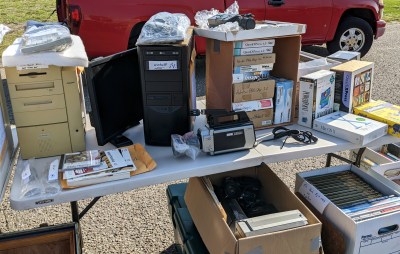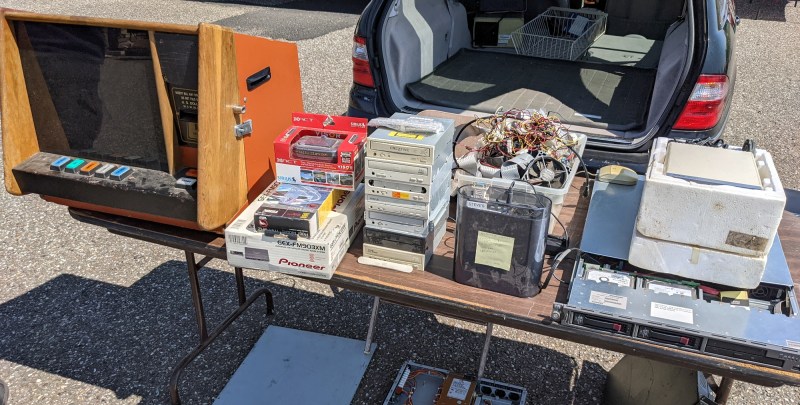There was a time where you could regularly find local swap meets to pick up computer hardware, ham radios, and other tech gear at the sort of cut-rate prices so often produced by a sense of camaraderie. But with the rise of websites like Craigslist and eBay, meeting up in person to buy and sell used hardware started to fall out of style. The fact that the prices had to go up due to the considerable cost of shipping such large and heavy objects was an unfortunate side-effect, but it wasn’t enough to stem the tide.
It’s unlikely that we’ll ever truly return to those early days. But if you’re within driving distance of Wall, New Jersey, you can take a step back in time on Saturday and experience a proper swap meet in all its glory. Hosted by the Vintage Computer Federation, the modest $5 entry fee goes to help support their worthy goal of preserving vintage computing history. After the swap meet officially wraps up at 2 PM, a short walk will take you over to their permanent exhibit located within the sprawling InfoAge Science and History Museum.
 I was able to visit the inaugural VCF Swap Meet back in 2021, and came away with a sense that this event had a bright future. At the time, the idea of holding an “old school” outdoor swap meet was born out of necessity — New Jersey’s relatively strict limitations on indoor gatherings during the COVID-19 pandemic made anything else largely untenable. But the response was so great that the VCF wisely decided to keep it going in post-pandemic times, and the event has only grown since then.
I was able to visit the inaugural VCF Swap Meet back in 2021, and came away with a sense that this event had a bright future. At the time, the idea of holding an “old school” outdoor swap meet was born out of necessity — New Jersey’s relatively strict limitations on indoor gatherings during the COVID-19 pandemic made anything else largely untenable. But the response was so great that the VCF wisely decided to keep it going in post-pandemic times, and the event has only grown since then.
This year, due to popular demand, the Swap Meet will feature food and drinks for purchase thanks to the South Monmouth Fire Museum — another worthy cause that’s currently working to establish their own presence within the InfoAge campus.
Whether you’re in the market for some vintage gear, want to support a good cause, or wish to explore the wide array of tech and history exhibits located within the former Camp Evans base, this is the perfect weekend to take a drive out and experience everything this unique little niche in the Jersey Shore has to offer.

















I remember buying old and big A3 dot matrix printers for their parts. They had some quite big stepper motors in them back then.. Those were the old days of the “HCC” in The Netherlands.
But in these modern times stuff is so far “optimised” that there is hardly anything worth salvaging in them. Printers nowaday’s are just a bunch of plastic junk with maybe still some steel parts in them.
New stuff has also gotten much cheaper. My first PC cost me 3200 Dutch Guilders (About EUR 1500 without “inflation correction”), and that was when I was still so young that even a bit of money was hard to get together.
My latest PC cost me EUR600 in parts (I already had an empty box and did not want to buy windoze).
In the old day, old stuff was also much more interesting because it was repairable. That is yet another reason for the 2nd hand market to be much less interesting. If you can still find some old test gear, you can download complete service manuals. For the new stuff, there is not even an schematic, and it’s probably some weird ass 1000 ball BGA on a mostly empty PCB.
“For the new stuff, there is not even an schematic, and it’s probably some weird ass 1000 ball BGA on a mostly empty PCB.”
In 1990s a scope like Rigol 1054Z would’ve been considered beyond amazing, university students would be allowed to “look but don’t touch” during labs. Today it’s an entry-level piece of junk that can be bought with single day wage of a junior IT worker.
I’ll take that over some fancy 0.1% resistors wire wrapped together to make a servicable boat anchor.
I agree somewhat with both of you. I prefer modern equipment too because it is more capable, smaller, lighter, … (and at least here in Europe those “boat anchors” are not so easy to get and so prices are rather high compared to modern stuff and shipping is obviously not cheap). However it is also true that there are no more schematics available (or only leaked stuff sometimes), components are often hard to identify, (de)solder and of course without the correct firmware nothing will work. So this “modern stuff” has both advantages and disadvantages (and that’s not only the case for test equipment but almost any electronics).
Well whatever. I’m a going. Last year I picked up a few prizes. Including a bag of items that reminds me of that term ender class at MIT where his students have until the last day to build the ultimate gadget. Also three Pocket PC devices, one’s a Jornada, from HP before they made the mistake of buying Compaq, and two Ipaqs from the after effect. I’m also going to listen to Tom’s Podcast whilst I am traveling there.